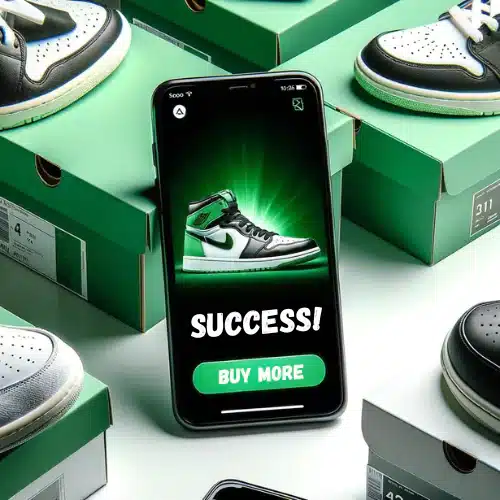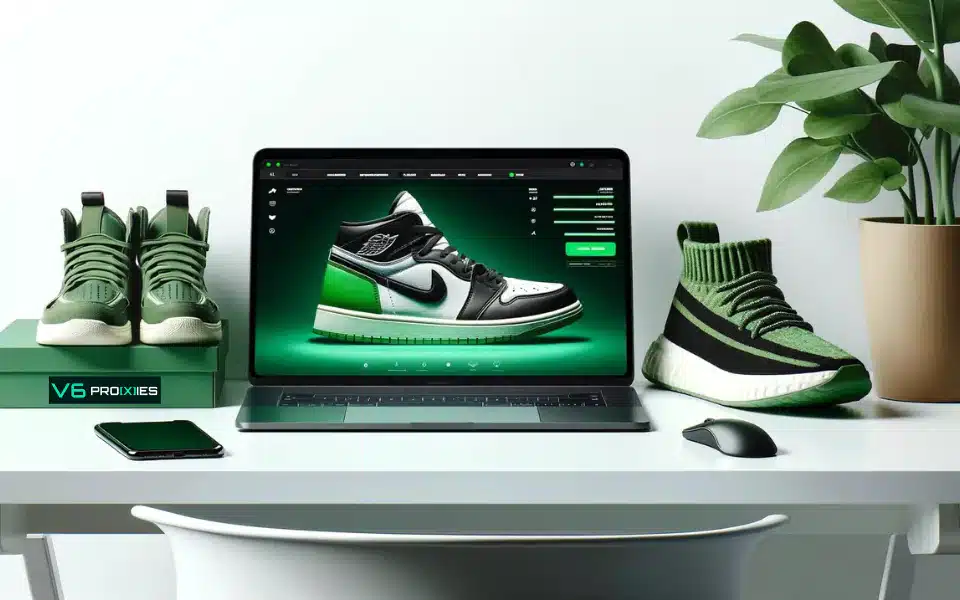In the business of sneaker copping for reselling, seconds matter. If you’re relying on manual methods to cop limited releases, you’re likely leaving money on the table and losing to competitors. That’s why sneaker botting is the answer. These automation tools can give you a significant edge, streamlining the buying process and boosting your chances of securing those high-demand drops.
In this guide we will give you the knowledge to level up your reselling game. Whether you’re a seasoned sneaker reseller or new to the scene, we’ll demystify the process so you learn:
- How do sneaker bots work and how to get them?
- What are the best sneaker bots in the market?
- How to make and use a shoe bot?
- How do sneaker proxies help shoe bots do their job?
- Is snkrs bot usage illegal?
- How much are sneaker bots? And more!
Table of Contents
- What Are Sneaker Bots?
- Is Sneaker Botting Legal?
- How Do Sneaker Botting Work?
- The 2 Types Of Sneaker Bots
- Where And How To Get Sneaker Bots?
- How Much Do Sneaker And Shoe Bots Cost?
- Best Sneaker Bots In 2024 (With Pricing)
- Setting Up Your Sneaker Botting Infrastructure
- How to Use a Sneaker Bot (Practical Focus)
- What Is Sneakers Backdooring & Is It Illegal?
- Beyond Sneaker Botting: Additional Tips
- Final Words!
What Are Sneaker Bots?
In the simplest terms, sneaker bots are software programs designed to automate the online purchase of limited-edition sneakers. They work by mimicking human behavior on retail websites but at lightning-fast speeds. Here’s how they give you the competitive edge:
- Rapid Detection: Bots continuously monitor sneaker release calendars and websites, pinpointing new drops the moment they go live.
- Instant Form Filling: Your personal information, billing details, and shipping address are filled in automatically, eliminating the time it takes to manually type them.
- Swift Checkout: Bots complete the checkout process faster than any human – sometimes in mere milliseconds.
- Multiple Entries: Advanced bots can submit multiple purchase attempts simultaneously, significantly increasing your chances of success.

Is Sneaker Botting Legal?
The legality of sneaker botting exists in a gray area. Here’s why it’s not a straightforward answer:
- Terms of Service Violations: Most sneaker retailers explicitly prohibit the use of bots in their terms of service. Using bots could result in your orders being canceled, accounts banned, or IP addresses blacklisted.
- The Law Is Unclear: While there have been legislative efforts to ban bots specifically for ticket sales (the BOTS Act of 2016 in the US), no such federal law exists for sneaker purchases.
- Local Laws: Some countries or states might have specific regulations regarding automated purchasing tools or website interactions. It’s advisable to be familiar with the laws in your jurisdiction.
How Do Sneaker Botting Work?
Sneaker botting operates on a few core principles that streamline the purchase process and give resellers a significant advantage:
- Website Monitoring: Bots are programmed to constantly scan specific sneaker websites or release calendars, looking for keywords or product codes that match upcoming drops.
- Automated Actions: Once a target release is detected, the bot springs into action. It rapidly navigates to the product page, automatically selects the correct size, and adds the item to your cart.
- Lightning-Fast Checkout: Your pre-loaded billing and shipping information is instantly populated into the checkout forms. In the blink of an eye, the bot completes the purchase process.
- Proxy Utilization: To avoid IP address bans, serious resellers use numerous sneaker and footsite proxies. These mask your true location, allowing the bot to send multiple purchase requests from seemingly different users and IP addresses.

The 2 Types Of Sneaker Bots
Different sneaker bot types offer options to suit different strategies and budgets. Here are the two main categories sneaker resellers need to know about:
1. AIO Shoe Bots (All-in-One)
- Versatility: These bots are designed to work across multiple sneaker retailers, giving you a wider reach. Popular examples include CyberSole (CyberAIO) and AIO Bot .
- Adaptability: All in one bots are frequently updated to stay ahead of anti-bot measures implemented by retailers.
- Tradeoffs: Versatility often comes at a higher price point, and sometimes AIO bots might be less optimized for a specific site compared to a dedicated bot programmed for Nike or Adidas sites.
2. Site-Specific Bots
- Laser Focus: These bots are tailored to work exceptionally well on a single retailer (like Nike, FootLocker, Supreme, etc.).
- Maximizing Success: By deeply understanding a single site’s structure and defenses, these bots can sometimes offer a specialized edge.
- Limitations: Should your target retailer change their website, your site-specific bot might become less effective.
Which Type is Right for You?
The best choice depends on your reselling strategy:
- Diversified Portfolio: If you target releases across multiple websites, an AIO bot likely offers the best flexibility.
- Niche Specialist: If you primarily focus on a single retailer, a site-specific bot could potentially give you that extra competitive edge.
Important Note: Always thoroughly research a bot’s reputation and success rates before investing. The sneaker bot market can be volatile, so it’s crucial to do your homework.
Where And How To Get Sneaker Bots?
The sneaker bot landscape is constantly evolving, but here are the primary avenues resellers should be aware of:
- Bot Marketplaces: Websites like BotBroker and Tidal Marketplace are reputable platforms for buying, renting and selling sneaker bots. These marketplaces feature a wide selection of bots, including options for new and resale purchases.
- Direct from Developers: Certain powerful bots are sold directly by their developers, usually through limited-quantity releases.
- Social Media and Forums: Reselling communities on Discord, Twitter, and other platforms sometimes offer bots, however, proceed with caution as scams are a risk.
- Sneaker Cook Groups: These private communities (often paid memberships) are hubs for sneaker botting knowledge. They offer access to bots, release information, success tips, and support networks.
Important Considerations Before You Buy Shoe Bots
- Reputation is Key: Thoroughly research the reputation of bot marketplaces, developers, sellers, and cook groups. Look for reviews, success stories, and community feedback before making a purchase or joining a group.
- Beware of Scams: The sneaker bot market can attract crooked individuals. Always use secure payment methods and exercise caution when dealing with unverified sellers or groups.
- Be Ready: High-demand bots often sell out quickly, requiring resellers to be ready during release drops or join exclusive cook groups.
More On Bots:
How Much Do Sneaker And Shoe Bots Cost?
Sneaker bot prices vary wildly, influenced by factors like success rate, supported sites, and features. Here’s a general breakdown:
- Free or Low-Cost Options: Some basic bots are available for free or with minimal upfront costs. Expect limited functionality and less frequent updates.
- Mid-Tier: Established bots often use a subscription model, with monthly or annual fees. These offer more features and support.
- Premium Bots: The most successful and sought-after bots can have upfront costs in the thousands of dollars and reoccurring renewal fees.
We will talk about actual numbers and prices in the next section.
Best Sneaker Bots In 2024 (With Pricing)
There is a great diversity of sneaker bot providers. This works for the benefit of users and resellers as these providers compete to provide better features and more affordable prices. Best sneaker bots in 2024 include:
- Kodai: This bot is highly regarded for its effectiveness across various platforms, including Shopify, Supreme, Footsites, Yeezy Supply, and Adidas. It’s known for its user-friendly interface and comprehensive dashboard, which provides valuable tools for users. The initial cost for Kodai is $175 for the first two months, followed by a $59.99 monthly renewal fee. On the aftermarket, a day’s bot rental can cost around $7.
- MEKpreme: Specializing in Supreme drops, MEKpreme is celebrated for its ability to bypass anti-botting measures and solve CAPTCHAs automatically. Its price is set at $168, with a renewal fee of $120 every six months. On the secondary market, it can go for as much as $1300.
- Balkobot: Known for its consistency and support across multiple sites including Shopify, Adidas, Supreme, Footsites, and Off-White, Balkobot charges $220 with a renewal fee of $60 for six months or $360 for a year. A lifetime copy of Balkobot sells for around $1,300 on the aftermarket.
- Ganesh Bot: Esteemed for its success in EU stores and a broad range of supported sites, Ganesh Bot has a price tag of £100 for 3 months. Its current aftermarket price stands at approximately $2,300.
- Wrath Bot: Recognized for its high reliability and advanced features on platforms like Shopify and Supreme, Wrath Bot has a resale value of around $6500, reflecting its demand and effectiveness in the competitive sneaker botting landscape.
- Nike Bot: A service for sneaker collectors to bypass Shopify checkout queues and solve captchas, costing $499/year.
- AIO Bot: Charges $325/year for creating customer accounts on e-commerce platforms and copping sneakers.
- Supercop Bot: Priced at $49.99, compatible with all Shopify website checkouts.
Setting Up Your Sneaker Botting Infrastructure
While the actual sneaker bot is essential, it’s just one piece of the puzzle. Here are the key components to consider for successful botting:
1. The Role of Residential Sneaker Proxies
- Avoiding IP Bans: Retailers track the IP addresses from which purchase requests originate. Sending too many requests from a single IP will quickly trigger anti-bot measures and get you banned.
- Masking Your Activity: Residential Sneaker Proxies act as intermediaries, routing your bot’s traffic through different IP addresses. This makes it appear as if multiple individual users are attempting to purchase, rather than a single bot. Residential proxies are tied to real home internet connections. This makes them significantly harder for retailers to differentiate from regular shoppers.
- Downside: Residential proxies are typically more expensive than other options.
- Potential Data Center Proxies Use Case: Datacenter sneaker proxies are more vulnerable to detection but they may be suitable for testing your bot setup or for less heavily defended websites.
2. The Role Of Servers (Optional)
- Speed Boost: For the most serious resellers, renting a powerful server located near the retailer’s data center can potentially reduce latency (the time for data to travel), giving your bot a slight speed advantage during high-traffic releases.
- Tradeoffs: Servers add significant cost and technical complexity to your setup. They are mainly worthwhile for high-volume botting operations.
3. Additional Tools
- Autofill Extensions: Browser extensions can help speed up checkout by automatically populating billing and shipping information, even without a full-fledged bot.
- Cook Groups: These communities are invaluable sources of knowledge. They often provide proxy recommendations, early release information, bot setup tips, and essential support.
Important Note: Setting up a robust infrastructure can be an investment. Always factor in the costs of proxies, servers (if needed), and potential cook group memberships when budgeting for your sneaker botting operation.
How to Use a Sneaker Bot (Practical Focus)
No sneaker reseller has a more precious goal than profit! That’s why you have to follow best practices and guidance to learn how to best use your sneaker bot.
1. Choose Your Target Release Wisely
- Not Every Drop is Worth It: Hyped sneakers often have limited stock and high competition. Don’t waste resources on releases with low chances of success or minimal profit margins.
- Do Your Research: Utilize release calendars, cook groups, and social media to gauge potential demand and resale value before committing your bot to a particular drop.
2. Sneaker Bot Configuration Steps
Disclaimer: Bot interfaces vary. This is a general overview to illustrate the concepts.
- Enter Site Details: Select the target retailer (e.g., Nike, Adidas, Foot Locker, etc.) from your bot’s supported list.
- Submit Personal & Billing Info: Enter your name, shipping address, and credit card details with extreme care. Errors can lead to failed purchases or order cancellations.
- Set up Keywords or Product Links:
- Keywords: If the exact product link isn’t available yet, input relevant keywords to help your bot identify the right item (e.g., “Jordan Retro Black Cement”).
- Product Link For known drops, pasting the direct product URL offers the most precision.
- Task Creation & Delays:
- Tasks: Most bots allow you to create multiple tasks, increasing your chances of copping a pair.
- Delays: Introduce small random delays between tasks to mimic human behavior further.
- Do The Testing:
- Never Skip Testing: Run your bot configuration on a less hyped release or a test mode (if available) to ensure everything works as intended.
- Check for Errors: Test runs expose misconfigurations in personal details, product targeting, or timing issues.
- Refine: Refine your setup based on test results before the high-stakes release day arrives.
Important Sneaker Bot Configuration Reminders
- Bots Don’t Guarantee Wins: Even the best setup can’t overcome limited stock and exceptionally high demand.
- Start Slow: Increase your number of tasks gradually as you gain experience and confidence.
- Stay Informed: Websites update their layouts and anti-bot defenses. Be prepared to make adjustments to your bot configurations over time.
What Is Sneakers Backdooring & Is It Illegal?
Yes, backdooring sneakers is illegal and falls under different areas of criminal law depending on the specific methods used. Before we say why let’s define it first.
What is Backdooring? Backdooring refers to obtaining limited-edition sneakers through dishonest or unfair means, usually by bypassing the standard purchase process. This could involve:
- Retailer Employees: Employees or store managers holding sneakers for select customers who don’t have to wait in lines or participate in raffles.
- Exploiting Vulnerabilities: Using technical knowledge to find loopholes in retailer websites, gaining an unfair advantage, or manipulating stock numbers.
- Insider Connections: Colluding with manufacturers or distributors to obtain sneakers before their official release date.

Why Is Backdooring Illegal?
- Theft/Fraud: Backdooring can involve varying degrees of theft or fraud, such as misappropriating inventory or misusing customer information.
- Breach of Contract: Employees typically violate employment contracts and retailer policies through backdooring practices.
- Unauthorized Access: In cases involving hacking or website exploits, unauthorized computer access laws might apply.
Consequences Of Backdooring
Aside from being illegal, backdooring is damaging to the entire sneaker community. Consequences include:
- Unfair Market: Honest collectors and even resellers relying on legitimate methods are left at a severe disadvantage.
- Damaged Reputation: Retailers and brands suffer reputational harm when backdooring scandals come to light.
- Prosecution: Those involved could face criminal charges, fines, and even jail time depending on the severity of the offense.
Beyond Sneaker Botting: Additional Tips
While bots can be powerful tools, don’t underestimate the value of these tried-and-true strategies:
1. Manual Strategies:
- Raffles: Participate in online and in-store raffles whenever possible. They often offer a better chance than release-day chaos. Raffles are a lottery-style system retailers use to sell limited-edition sneakers. Customers enter for a chance to win a random chance to purchase the shoes.
- Store Accounts: Create accounts on retailer websites in advance, with your information pre-saved for faster checkout on drop days.
- Release Calendars: Religiously track reliable release calendars to stay ahead of upcoming drops.
2. keeping up with sneaker release news
- Drop Details: Research specific releases. Know the exact drop time, expected stock numbers, and potential prices on the resale market.
- Retailer Specifics: Some retailers or product pages might have unique quirks that a bot won’t inherently know about. Individual knowledge matters!
3. Accepting Defeat:
- Profit Potential: Don’t chase every hyped release. Calculate potential profits realistically – factor in your costs (bot, proxies, etc.)
- It’s a Game of Odds: Even with the best tools and preparation, you won’t always win. Be ready to accept losses gracefully.
Final Words!
Successful sneaker botting involves a combination of technical setup, strategic planning, and a dose of luck. It is also a constantly evolving game. Stay informed, stay adaptable, and above all, maintain an ethical approach to reselling.Ready to level up your botting game? Don’t let IP bans hold you back. Visit our sneaker proxies service page to equip yourself with the most reliable residential proxies on the market, giving your bots the edge they need to succeed.


